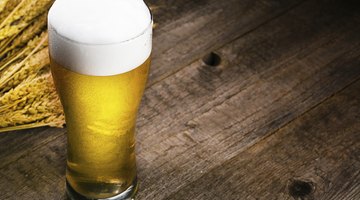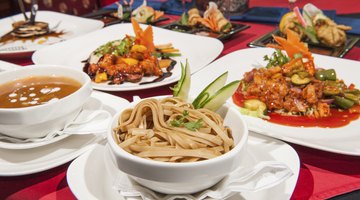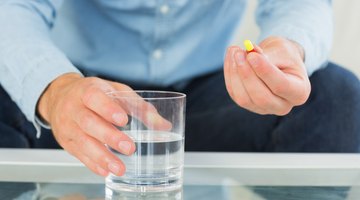Fever Blisters & Orange Juice
The National Institute of Dental and Craniofacial Research estimates that 500,000 Americans experience their first bout of fever blisters every year. Fever blisters, also called cold sores, usually occur outside the mouth -- on the lips, chin, cheeks or nostrils. They are caused by the herpes simplex type 1 virus. Twenty to 40 percent of Americans experience recurrences, sometimes six or more per year. Although the frequency tends to decrease over time, the blisters may still occur in response to triggers such as stress, illness, dental work and diet. Orange juice is a common food trigger for fever blisters.
Chemical Properties
Scientists describe the chemical properties of foods and other substances in terms of pH. The pH scale runs from 0 to 14. The midpoint, 7, is considered neutral. Acidic foods feature pH between 0 and 7. The lower the pH, the more acidic the substance. For example, the pH of battery acid is about 2, while the pH of the human body is about 7.4. Among foods, orange juice is one of the most acidic, with a pH that ranges from 3.3 to 4.1. This acid can produce subtle corrosions in the tissue of the mouth that set the stage for a fever blister outbreak.
Physical Properties

Causes of Mucus in the Stools & Abdominal Pain
Learn More
Scientists describe the physical properties of foods and other substances in term of states, such as solid, liquid or gas. People consume orange juice in the form of a liquid, which tends to magnify the effects of its acidity. This is because foods in the solid state tend to stick together in the mouth, limiting their contact with the surrounding tissue. On the other hand, foods like orange juice move freely, actually bathing the surrounding tissue and prolonging contact with the damaging acids.
Nutritional Properties
The nutritional properties of food encompass “macronutrients” -- substances such as proteins, sugars and fats that are measured in grams -- and “micronutrients”-- substances like vitamins, minerals and phytochemicals that are measured in milligrams and micrograms. Orange juice supplies rich quantities of beneficial micronutrients like vitamin C and phytochemicals called flavonoids, both of which enhance the ability of the immune system. However, it also contains relatively large amounts of simple sugars, macronutrients that impair the ability of the immune system to fight fever blisters.
Considerations

The Side Effects of Monosodium Glutamate (MSG)
Learn More
Although some people report that drinking orange juice triggers fever blisters, the National Library of Medicine lists no studies that confirm this. Triggers can vary from person to person. Keeping a daily food diary can reveal whether drinking orange juice really triggers fever blisters, whether orange juice triggers fever blisters only in conjunction with other triggers like stress or dental work or whether there is no relationship at all. Most likely, it’s the second scenario and several factors act together to trigger the outbreak. MedlinePlus does, however, recommend abstaining from orange juice and other citrus fruits once an outbreak occurs.
Alternatives
For people who cannot give up orange juice, drinking through a straw can help because it minimizes contact between the juice and the tissues of the mouth. Consuming whole fruit instead of juice also helps because, like drinking through a straw, the solid state of whole fruit reduces contact between the juice and the mouth. A third option is to apply over-the-counter mouth or lip ointments before consuming orange juice. Although the ointments eventually wash away, they provide a temporary protective barrier between mouth tissue and acids.
Related Articles
- National Institute of Dental and Craniofacial Research: Oral Health in America: A Report of the Surgeon General
- “Alternative Medicine Reviews”; Natural Remedies for Herpes Simplex; Alan R. Gaby, M.D. ; December 2005
- MedlinePlus: Mouth Sores











